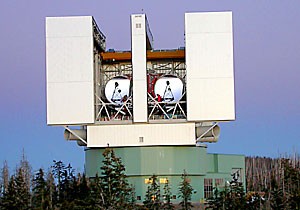UA scientists, in conjunction with a group of international researchers, have discovered that the Hercules Dwarf Galaxy 430,000 light years away is nearly flat, making it different from previously found galaxies.
“”Most of the other dwarf galaxies are very spherical,”” said Jill Bechtold, an astronomy professor. “”The weird thing we found was this one was actually elongated like a cigar.”” She said the cylindrical shape is fatter in its center and thinner at the edges, where the stars are more spread out.
The Sloan Digital Sky Survey, which charts out a quarter of the sky, discovered the galaxy, but it took the Large Binocular Telescope on Mount Graham to discern its surprising shape.
Dwarf galaxies – with only a few billion stars, compared to the possibly 400 billion in the Milky Way – orbit around larger galaxies in a complex pattern of their own.
Because they do not have massive cores as the Milky Way does, dwarf galaxies previously examined have always appeared more rounded, Bechtold said.
There are two current theories to explain the shape.
“”It may be rotating, but that would be odd,”” Bechtold said.
She believes that something around the galaxy’s orbit around the Milky Way is putting tidal stresses on it. The orbit of the galaxy around the Milky Way and the shifting of its distance relative to our galaxy is making the gravitational pull on one side stronger than the other, stretching it out.
On a much smaller scale, this sort of gravitational change causes tides in the oceans.
The galaxy “”seems to have a very old stellar population,”” said David Sand, a Chandra Doctoral Fellow who studies star development and is working on a follow-up paper about the dwarf galaxy.
While there does not appear to be any rotation, making the tidal stress theory even more likely, the galaxy still remains a mystery, he said.
The only other dwarf galaxy to have a similar shape is the Sagittarius Dwarf Galaxy, which is 10 times closer to the Milky Way, making it even more difficult to explain the Hercules Dwarf’s shape, Bechtold said.
The Large Binocular Telescope is one of very few able to look closely enough at the Hercules Dwarf Galaxy to make out details like shape, she said.
The telescope is a cooperative project involving several academic institutions in the U.S., Germany and Italy, including the UA, Ohio State University and the Max Planck Institute in Berlin, she said.
The next step in studying the dwarf galaxy is to take the light spectra of its stars, to get a better idea of its makeup, she said.
As for the galaxy’s odd shape, Bechtold said, “”It really is the story right now, and there will be a lot of new results about it in the next couple of years.””









